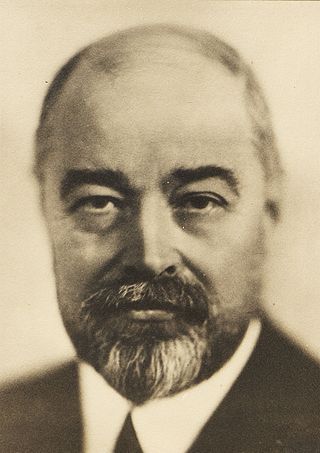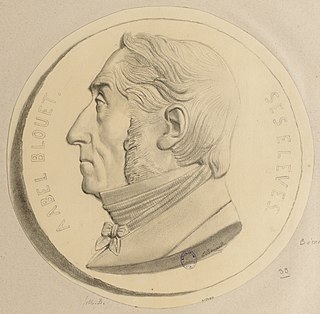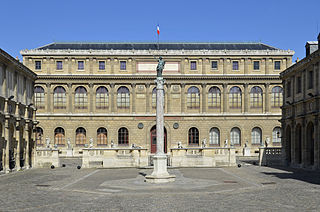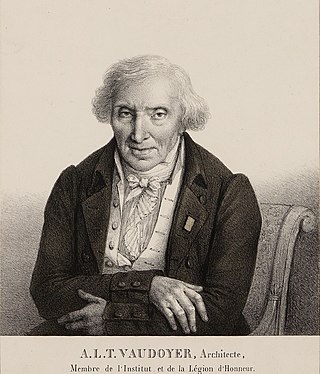This article needs additional citations for verification .(March 2022) |

Constant Moyaux (15 June 1835, Anzin - 11 October 1911, Paris) was a French architect.
This article needs additional citations for verification .(March 2022) |

Constant Moyaux (15 June 1835, Anzin - 11 October 1911, Paris) was a French architect.

He was the son of a carpenter. He began studying architecture in 1852, at the academy in Valenciennes, then went to Paris, where he enrolled at the École des Beaux-Arts. His primary instructor there was Louis-Hippolyte Lebas. Over the course of the late 1850s, he won several medals and awards. He was the second student to receive the "Prix de Rougevin" (1857); established by the architect Auguste Rougevin (1794-1878), in memory of his son, who had died while studying there.
In 1861 his honors culminated, when he won the Prix de Rome, with his design for a thermal bathing establishment. From 1862 to 1866, he was at the Villa Medici in Rome, but also travelled extensively; throughout Italy as well as to Athens and Istanbul.
When he returned to Paris, he served as an inspector of civil buildings and national palaces from 1867 to 1874. The following year he was named a professor, and appointed as head of the architecture studio at the École; a position he held until his retirement in 1908. His students there included Max Sainsaulieu, Louis Duthoit, and Adolphe Dervaux .
In 1879, he was made a Knight in the Legion of Honor. [1] He began one of his major works that same year; converting the fire-damaged Château Neuf at Meudon into an observatory. This project would occupy him until 1888. He also performed a major renovation at the Ministry of the Interior from 1882 to 1883. An appointment as Inspector General of Civil Buildings came in 1894. Four years later, he was elected to the Académie des Beaux-Arts, where he took Seat #4 for architecture, succeeding Charles Garnier (deceased).

While attending festivities in his honor, in Anzin, he fell and skinned his head. The wound became infected, and he died of tetanus while undergoing treatment at the Institut Pasteur. His books and papers were bequeathed to the library in Anzin. The Musée des Beaux-Arts de Lille maintains a collection of his drawings.

Paul Bigot was a French architect.

Guillaume-Abel Blouet was a French architect who specialised in prison design.

École des Beaux-Arts refers to a number of influential art schools in France. The term is associated with the Beaux-Arts style in architecture and city planning that thrived in France and other countries during the late nineteenth century and the first quarter of the twentieth century.

Jean-Nicholas Huyot was a French architect, best known for his 1833 continuation of the Arc de Triomphe from the plans of Jean Chalgrin.

Emmanuel Pontremoli was a French architect and archaeologist.

Roger-Henri Expert was a French architect.
Jean Dubuisson was a French architect who is regarded as one of the leading practitioners of the French post-World War II years.
Edmond Jean-Baptiste Paulin was a French architect. As a young man, he became known for his reconstruction of the Baths of Diocletian. Later he taught at the National School of Fine Arts, and designed pavilions for two world expositions.

Louis Bernard Bonnier was a French architect known for his work as an urban planner for the city of Paris. He was instrumental in loosening the restrictions on the appearance of buildings in Paris, which resulted in the blossoming of Art Nouveau buildings. He designed many significant buildings himself, including private villas, public housing and railway buildings. In all his work he was true to the rationalist principles of Art Nouveau.

Stanislas-Louis Bernier was a French architect.
Louis-Denis Caillouette was a French sculptor. His pupils included the medallist Adrien Baudet

Henri Adolphe Auguste Deglane was a French architect.

Antoine-Laurent-Thomas Vaudoyer was a French architect. He was married to Alexandrine-Julie Lagrenée, daughter of the painter, Louis Jean François Lagrenée. Their son, Léon, was also a well-known architect.

Paul-René-Léon Ginain was a French architect.

Jean-François Heurtier was a French architect.

Gustave Umbdenstock was a French architect; most familiar for his railway stations.

Arthur-Stanislas Diet was a French architect and watercolorist.

Alfred-Nicolas Normand was a French architect and photographer.

Georges-Ernest Coquart, or Ernest-Georges Coquart was a French architect.

Joseph Henri Lemonnier was a French art historian; the first to hold the chair of art history at the Sorbonne.